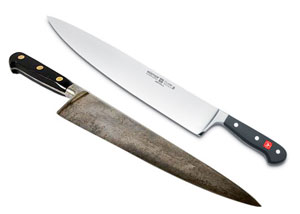 Very basically, here are some principles of cutlery steel:
Very basically, here are some principles of cutlery steel:
- Hardness: a knife blade has to be hard enough to hold an edge but, if it is too hard, it becomes brittle and can break or chip easily. The correct hardness of the steel is achieved through “tempering”. Simply put, tempering is a process of heating the steel to a precise, high temperature and then cooling it quickly by quenching the blade in liquid. The hardness of cutlery steel is measured on the Rockwell scale which ranges between 0-100. A good kitchen knife usually comes in around the high 50’s on the Rockwell scale…
- “Stainless” steel vs. Carbon steel: carbon is the element in cutlery steel that allows it to be tempered. Carbon is also the element that makes a blade turn gray and causes rust. For most of history - since steel was first invented - cook’s lived with gray, splotchy blades because that was the price of admission for a quality knife. After the first World War, a process that involved adding chromium to steel to make it “stain-free” was first applied to knives. These early attempts created blades that didn’t tarnish but were difficult to sharpen. The result was that early stainless steel developed a bad reputation (which some still, mistakenly, believe today ). However, science caught up in the 1950’s with the development of “high-carbon” stainless steel which holds the edge, can be resharpened and, with proper care, does not tarnish…
(to be continued…)
Labels: Knives
0 Comments:
Post a Comment
Subscribe to Post Comments [Atom]
<< Home